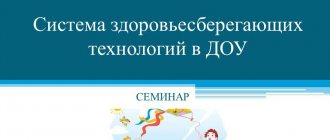MAGAZINE Preschooler.RF
Long-term project “Innovative technologies in the development of speech of children of senior preschool age”Project information card:
Full name of the project “Correct speech is the key to success”
Type, type of project - long-term, creative - educational.
Venue—MADOU Kindergarten No. 9 (building 2) Uchaly, Republic of Bashkortostan
Dates: September 2021 –March 2021
Project participants: students of preparatory group No. 9 (kor. 2), teachers, speech therapist, music director, parents of students.
Children age 6-7 years
Explanatory note:
This project is designed for children 6-7 years old. It is at this age that children become motivated and interested in expanding their vocabulary and learning to read and write, and there is a sharp jump in the ability to pronounce words clearly and correctly. Children take part in theatrical productions with pleasure and emotionally absorb works of fiction and poetry with great interest. This must be used to instill skills and knowledge in the field of comprehensive speech development. The project will be implemented in several directions: working with children, achieving the main goal and solving main problems; working with parents. Only with the help of parents can the maximum effect be achieved. The project involves the use of innovative forms and methods of presenting material to children, these are stories and practical exercises, video and photo materials, vocabulary games during classes, the use of demonstration material, didactic games, matinees, entertainment, individual work, educational games by Voskobovich “Larchik” , storytelling, “Fairy tales for the tongue” .
Rationale.
Currently, due to the widespread use of electronic media, a very young child is seated with a phone, tablet, laptop, etc. Hence, the problem of speech development in children is still relevant. Problems with clear pronunciation of words and sounds. Inability to retell text, describe objects, conduct dialogues, monologue speech, unwillingness to concentrate on the book.
And it is in older preschool age that these gaps should be filled by instilling the necessary skills and knowledge. You can often encounter parents’ indifference and lack of understanding of the importance of this issue. Ignoring this problem gives rise to a gradual decline in cognitive skills in the child. All this will affect the child’s arrival at school, on a mental and physical level. “Correct speech is the key to success” was developed.
This project includes an incomparable, versatile, educational effect. It is this, in combination with different types of activities, that ensures the formation of the full development of children of senior preschool age. It contributes to the development of their ability to organize their leisure time in an interesting and meaningful way; increases the motivation of the child and his parents to lead an interesting, educational lifestyle.
Approaches to project implementation:
- system-activity – development of a system of activities to develop knowledge and skills in environmental management among early preschoolers and their parents;
- culturological – organization of the behavior of children and their parents in nature based on the formation of their cultural relations to nature and the environment.
Goal: relying on new technologies, to create conditions for preserving and strengthening children’s interest in developing their speech. Expand and strengthen children’s storytelling skills, inventing a plot, and imagining. Develop the emotional sphere of children of senior preschool age.
Tasks:
Improve and enrich children's cognitive experience in speech development
Teach children knowledge and skills using new techniques and methods
Encourage children to speak clearly and correctly.
To educate and develop attention, independence, thinking, memory in children
Principles
- the principle of controllability and purposefulness - involves creating conditions for the formation of children's knowledge of speech development
- the principle of effectiveness – aimed at achieving intellectual and practical results.
Expected results: in speech development
- The ability to independently compare objects with each other, name several significant signs of similarity and difference.
- Independently compose a coherent story of at least 6-7 sentences.
- Write stories from personal experience
- Change words to form new ones
- Retell short stories
- Correctly use difficult forms of familiar words
- Use anonymous names in speech
In teaching literacy
- Determine the number of syllables in words
- Determine the number of sounds in words
- Determine the place of a given sound in a word
- Analyze the sound composition of a word
- Identify stressed syllables, stressed vowels
- Distinguish between consonants and vowels
- Distinguish between hard and soft sounds
- Make sentences of 2-3 words
Sound culture of speech
- Reinforce the correct pronunciation of sounds
- Pronounce sounds clearly and accurately with varying voice levels
- Differentiation of sounds in tongue twisters, in pure tongue twisters
Theatrical activities
- Emotional and aesthetic perception of works
- Introduction to fiction
- Introduction to folklore
Used Books:
- V. V. Gerbova “Speech development in kindergarten” Mosaic-City Moscow, 2014. -112 s.
- A.V. Aji “Notes of integrated classes in the preparatory group” Voronezh shopping center “teacher” , 2006 -333p.
- N.S. Golitsina “Summaries of complex thematic classes” -M. "Scriptorium" , 2013 -568 pp.
- L.V. Upravleeva “Preparation for school in kindergarten. Counting, reading, speaking, thinking" Yaroslavl. Development Academy, 2007-224
- N.N. Gladysheva, Yu.B. Sergeantov “Teacher’s work program” - Volgograd 2014. -445 s.
- T.S. Komarova, N.E. Veraksy, M.A. Vasilyeva “Complex classes” - Volgograd-2014. -415s.
- Children's reading book for children 6-7 years old.
- Internet resources “Voskobovich’s Manuals” , “Storytelling”
| Next > |
Traditional and innovative technologies of speech development in the work of a teacher
author: Polina Evgenia Yurievna
teacher-speech therapist Municipal budgetary preschool educational institution "Child Development Center - Kindergarten No. 67" Nakhodka
Traditional and innovative technologies of speech development in the work of a teacher
Municipal budgetary preschool educational institution
"Child Development Center - Kindergarten No. 67" Nakhodka
Traditional and innovative technologies
speech development in the work of a teacher
Author-compiler:
E.Yu. Polina – speech therapist teacher
Nakhodka
2020
Traditional and innovative technologies
speech development in the work of a teacher
The Federal State Educational Standard for Preschool Education identifies the educational area “Speech Development”, which provides for:
- children's mastery of speech as a means of communication and culture;
- enrichment of the active vocabulary;
- development of coherent, grammatically correct dialogical and monologue speech;
- development of speech creativity;
- development of sound and intonation culture of speech, phonemic hearing;
- acquaintance with book culture, children's literature;
- listening comprehension of texts from various genres of children's literature;
- the formation of sound analytical-synthetic activity as a prerequisite for learning to read and write.
The organization of children's speech development in a preschool educational institution in modern conditions involves the search for effective technologies for the development of children's speech.
When choosing pedagogical technologies for the development of speech in preschool children, it is important that the technology is not only adequate to the age-related capabilities of the children, but also provides a guaranteed result for the development of speech in different forms of work.
Such technologies include:
- health-saving and health-forming technologies;
- modeling technologies;
- "Mnemonics";
- information and communication technologies;
- technology for teaching children how to write riddles;
When choosing a technology, you must focus on the following requirements:
- technology is focused not on learning, but on the development of children’s communication skills;
- nurturing a culture of communication and speech;
- technology must be health-saving;
- the basis of the technology is person-oriented interaction with the child;
- implementation of the principle of the relationship between cognitive and speech development of children;
- organization of active speech practice for each child in different types of activities, taking into account his age and individual characteristics.
The defining moment in successfully solving the problems of developing coherent speech in preschool children is the correct choice of pedagogical technologies that would not only be adequate to the age-related capabilities of the children, but also provide the ability to easily solve speech problems in various forms of work with children.
"Mnemonics"
Authors: V.K. Vorobyeva, T.A. Tkachenko, V.P. Glukhov, T.V. Bolsheva, L.N. Efimenkova and others.
Mnemonics is a system of methods and techniques that ensure effective memorization, preservation and reproduction of information through the formation of additional associations. This system of methods promotes the development of different types of memory (auditory, visual, motor, tactile), thinking, attention, imagination and speech development of preschool children. It is widely used in teaching children to retell works of fiction while learning poetry, etc.
“Mnemonics” uses the natural memory mechanisms of the brain and allows you to fully control the process of memorizing, storing and recalling information.
The use of mnemonics in the speech development of preschool children contributes to preschoolers’ creative knowledge of the phenomena of their native language, the construction of independent coherent statements, and the enrichment of vocabulary.
Technologies for using modeling in speech development
preschool children
(T.A. Tkachenko, M.M. Alekseeva, V.I. Yashina)
The use of visual models in the process of teaching children to construct coherent statements allows the teacher to purposefully develop skills in using various grammatical structures in speech, describe objects, and compose creative stories. The inclusion of visual models in the process of teaching speech helps to consolidate understanding of the meanings of parts of speech and grammatical categories, develop an understanding of logical-grammatical structures and holistic speech utterances.
The most widespread in teaching preschool children independent storytelling are the schemes for composing descriptive and comparative stories developed by T.A. Tkachenko.
Symbolism helps children identify the main features of a toy, retain the sequence of descriptions in memory, and compose a descriptive story.
The presence of a visual plan makes children's stories clear, coherent, complete, and consistent, so the use of modeling is advisable when teaching how to compose not only descriptive, but also narrative stories.
Technology for teaching children how to write riddles
Traditionally, in preschool childhood, working with riddles is based on guessing them. Moreover, the methodology does not give specific recommendations on how and in what way to teach children to guess hidden objects.
In the process of composing riddles, all the child’s mental operations develop, and he receives joy from verbal creativity. In addition, this is the most convenient way to work with parents on the development of the child’s speech, because in a relaxed home environment, without special attributes and preparation, without interrupting household chores, parents can play with their child in composing riddles, which contributes to the development of attention , the ability to find the hidden meaning of words, the desire to fantasize.
Information and communication technologies
ICTs make it possible to make each lesson unconventional, bright, rich, lead to the need to use different ways of presenting material, and provide a variety of techniques and methods of development and training.
Health-saving and health-forming technologies
Logorhythmics
– the relationship between speech, music and movement.
Finger gymnastics
- games and exercises for the development of small arm muscles (with and without objects).
Breathing exercises
– exercises aimed at developing deep inhalation and long exhalation.
Articulation gymnastics
- development of correct, complete movements and certain positions of the articulatory organs necessary for the correct pronunciation of sounds, and the combination of simple movements into complex ones. The main task is to develop accuracy, strength, pace, and switchability of movements.
Su-Jok
The Su-Jok therapy method for the development of children's speech is used in almost all speech therapy classes. It is actively used in medicine, psychology, and pedagogy. The effectiveness and simplicity of the method are impressive. What is the secret of the effectiveness of the method, which, if used correctly, will certainly give positive results.
The use of Su-Jok therapy for the development of children's speech is justified by speech therapy practice. The method can be used both for the correction and prevention of speech disorders. Su-Jok is a stimulator-massager, it is a plastic ball with small spikes and divided into two halves. Inside it are two rings. The rings are made of elastic metal wire and stretch very well. The palms are massaged with a ball, and we massage the fingers with rings. At the same time, a pleasant, tingling sensation is felt throughout the body.
Having determined the zones of correspondence of speech-producing organs and systems, it is possible to influence them in order to prevent and correct speech disorders. Two zones located in the cerebral cortex are responsible for speech. Wernicke's area is responsible for speech perception and Broca's area is responsible for the pronunciation of sounds. According to the Su-Jok theory, the points corresponding to these zones are the upper phalanges of the fingers. Therefore, when massaging Su-Jok with a ball, it is necessary to pay attention to this particular part of the hands. However, taking into account all of the above, it is necessary to stimulate other points of correspondence in order to improve the health of the whole organism.
With the help of the Su-Jok therapy method, many correctional problems are solved. Such as:
- development of phonemic hearing and perception;
- pronunciation correction (automation and differentiation of sounds);
- development of sound and syllabic analysis of words;
- activation of the dictionary and improvement of lexical and grammatical categories;
- development of general and fine motor skills;
- development of mental processes;
- development of color perception;
- development of space-time concepts.
Sources:
T. V. Bolsheva “Learning from a fairy tale”
Maksakov A.I., Tumakova G.A. "Learn by playing"
Alekseeva M.M., Yashina V.I. “Methods of speech development and teaching the native language of preschoolers”
Park Jae Woo “Su-Jok for everyone”
Traditional and innovative technologies of speech development in the work of a teacher





